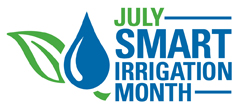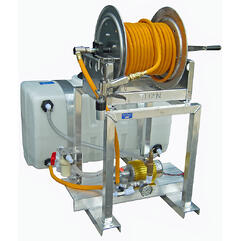 Whether you manage a farm, run Public Works or maintain a golf course, managing and conserving resources to improve water availability is key. According to the Environmental Protection Agency, of the 26 billion gallons of water consumed daily in the United States, approximately 7.8 billion gallons (30%), is devoted to outdoor expenditures with the majority used for irrigation. As you might have assumed, the amount of water used outdoors
Whether you manage a farm, run Public Works or maintain a golf course, managing and conserving resources to improve water availability is key. According to the Environmental Protection Agency, of the 26 billion gallons of water consumed daily in the United States, approximately 7.8 billion gallons (30%), is devoted to outdoor expenditures with the majority used for irrigation. As you might have assumed, the amount of water used outdoors
peaks during the summer, particularly during the month of July.

We all need to do our part to conserve and given that it is Smart Irrigation Month, an initiative dedicated to promoting efficient irrigation empowering professionals with knowledge to help save water, we at Sprayer Depot thought it was only fitting to provide a refresher with a few strategies to help you do your part to conserve this natural resource. Here’s to spraying smarter.
Off the top of your head, you might be thinking of water conservation tips like determining the amount and timing of irrigation for efficient water use. You’re right on track. Another tactic to consider is monitoring water application for crop needs and soil moisture content. Take a look at the five tips below to ensure you spray smarter during Smart Irrigation Month:
- Consider soil type. Type of soil determines how quickly water can be absorbed without runoff. Watering more than soil can absorb causes runoff and waste. Light sandy soils hold less water than heavy clay soils.
- Water only when needed. Saturate root zones and let the soil dry. Watering too much and too frequently results in shallow roots, weed growth, disease and fungus. Learn your crop’s water requirements by determining how much water the crop has used, then on the next irrigation only water long enough to replace that amount of moisture.
- Water at the best time. Watering during the heat of the day may cause losses of up to 30 percent due to evaporation. Prevent water loss by watering when the sun is low or down, winds are calm and temperatures are cool – typically between the evening and early morning.
- Water more often for shorter periods. For example, watering for three, 5-minute intervals let soil absorb more water than watering for 15 minutes at one time, reducing runoff.
- Adapt watering to the season. Adjust the watering schedule regularly based on seasonal weather conditions. These vary by state and region. For example, many utilities rely on stored water from winter snowpack that gradually releases water from the melting snow during spring and summer. And the monsoon season in the Southwestern United States causes flash flooding during the summer season, effecting crops and landscapes alike.
In addition to these strategies to conserve water, you should also inspect your sprayer equipment to ensure it is in proper working order, free of leaks. Read our recent post on sprayer pump repair kits and routine maintenance if you haven’t already conducted your seasonal sprayer inspection.
Smart Irrigation Month is an initiative of the Irrigation Association, a non-profit industry organization dedicated to promoting efficient irrigation.

.png?width=280&name=SameDayShippingGuarantee-New%20(1).png)



